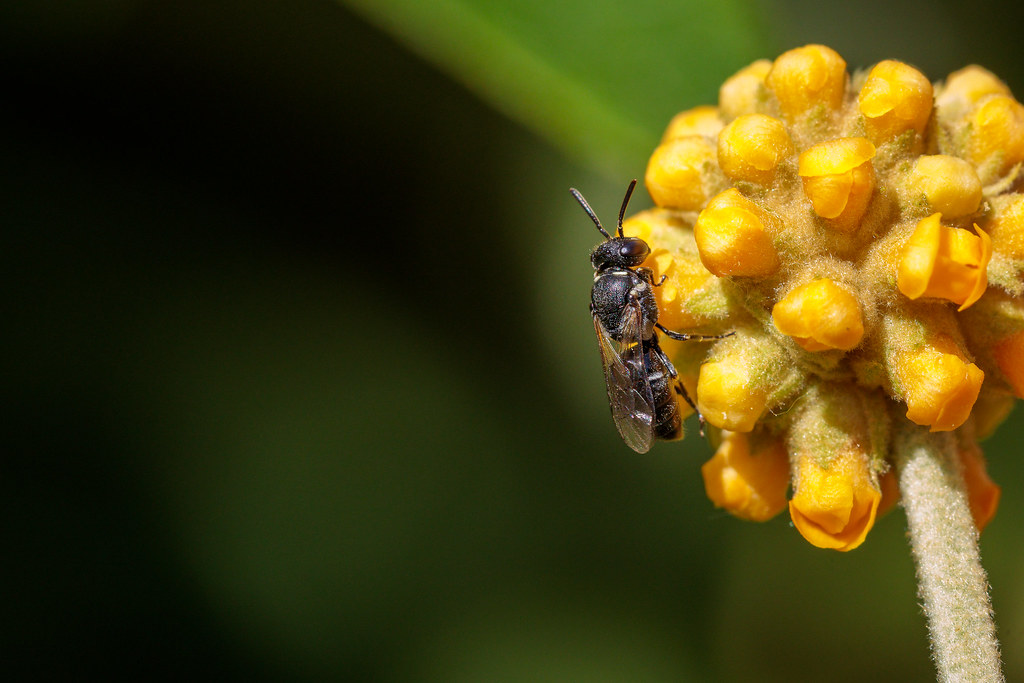#hylaeus yellow faced bee
Text

Hairy Yellow-face Bee
A hairy yellow-face plasterer bee, feeding on an ox-eye daisy flower in the garden.
#30dayswild#bee#bees#canon#canonuk#fauna#garden#hairy yellow-face#hylaeus hyalinatus#insect#insects#invertebrate#invertebrates#minibeast#minibeasts#nature#outdoors#plasterer bee#spring#springwatch#wildlife
12 notes
·
View notes
Text
meet hylaeus longiceps

(source)
this bee is endemic to hawaii (oahu, molokai, lanai, and maui) and otherwise known as the longhead yellow-faced bee
it's found in coastal and dry shrubland habitats - we don't know much about their nesting behaviour, but they're solitary bees who use pre-existing holes, and are typically found at ground-level
in 2016 they became the first bees to ever be placed on the US endangered species list - they're under threat from habitat loss/degradation, loss of host plants, natural disasters and the introduction of exotic plants/animals/agricultural and recreational activities
#really had to work to find photos of this one!!!#(pictured is a male)#bees#wildlife#zoology#ecology#hylaeus
44 notes
·
View notes
Photo

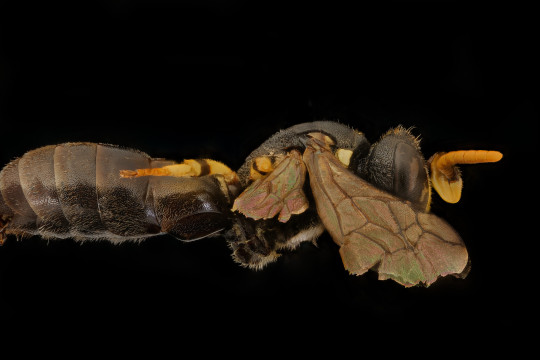

Hylaeus dilatatus (Chalk Yellow-face Bee) from the Netherlands. Note in this male the greatly expanded scapes (these are the first antennal segments). Females do not have these expansions and across the genus Hylaeus males range from female style scapes to giant ones like this. Makes you think it is some how linked to sexual selection...but exactly what its use is unclear. Other bee genera that I can think of do not have these expanded scapes.
50 notes
·
View notes
Video
During our photoshot today , A Bee suddenly flew on our plate and fitted perfect with our delicious marlenka honey coffee cake, If she likes it we know you will too.
Come join all the buzz.
Během našeho dnešního focení k nám na talíř neočekávané přiletěla včela a perfektně se hodila k našemu lahodnému kávovému dortíku marlenka. Pokud jí chutná, víme, že vám bude také.
Přijďte se připojit ke všem buzzům.
Random Fact : The Bee Is A Yellow Faced Bee (genus Hylaeus)
Uhelný trh 526/6 - Havelská 526/2 - V Kotcích 526/1 Staré Město, 110 00 Praha 1.
1 note
·
View note
Text

Pollinator of Focus for Plant Diversity: Hawaiian | Hylaeus Yellow-Faced (Masked) Bee
As of September 30th, 2016, seven of the Hylaeus bee genus have been placed on the the U.S. critically endangered list, an alarming first for the bee species.
What happened to them?
Factors behind their population decline include:
The growing invasion of predatory species (Argentine ants and wasps).
The introduction of foreign flora from human efforts to reinvigorate Hawaiian sites impacted by wildfires.
Unregulated use of insecticides.
Destruction of habitats from urbanization and land use conversion.
Their role in plant and flower diversity:
Masked bees are no larger than a quarter of an inch, unlike their larger sized counterparts, honey bees, which were brought to Hawaii in 1857. Due to their small size, masked bees are allowed to burrow into deep throated flowers for nectar and pollen, where larger sized bees are unable to get through.

(Image of a Swamp Milkweed)
["Solitary bee (Hylaeus?), Sandy, Bedfordshire" byorangeaurochs is licensed under CC BY 2.0]
"Swamp Milkweed (1817)" by Swallowtail Garden Seeds is marked with CC PDM 1.0
#save the bees#protect the bees#protect nature#swamp milkweed#perennial#perennial flowers#perennial flower#yellow faced bee#hylaeus yellow faced bee#masked bee#masked face bee#biodiversity#plants#endangered#endangered species#bee#bees#honey bee#native bees#native bee#cherish-a-bee#flowers#nature#save the environment
57 notes
·
View notes
Photo

She realizes color
#Hawaiian yellow-faced bee#Hylaeus sp.#macro#photography#original photographers#photographers on tumblr
0 notes
Text
Bees
Part 3
So as a follow on from Bumblebees and Honeybees we're gonna dip into the oh so complex world of solitary bees!
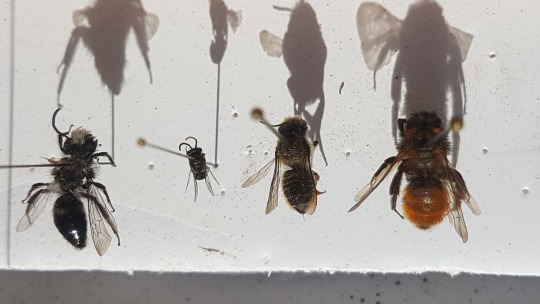



Here we have some pretty common Bees from 3 different families.
From left to right we have:
Andrena cineraria (male)
Hylaeus hyalinatus (male)
Megachile centuncularis (female)
Andrena fulva (female)
Okay so the A. cineraria is crushed but I found him. Finders keepers. Theyre a fairly common bee and nest in the ground although theyre solitary they tend to nest in the same area so youll see lots together. Even though they appear black they do have a lovely blue sheen, and are one of Als favorites.
The H. hyalinatus is another lovely bee. This striking yellow faced bee is just so tiny! He comes in under 5mm and arent really that fussy about where they nest it seems (thats what I think he is Hylaeus at least!)
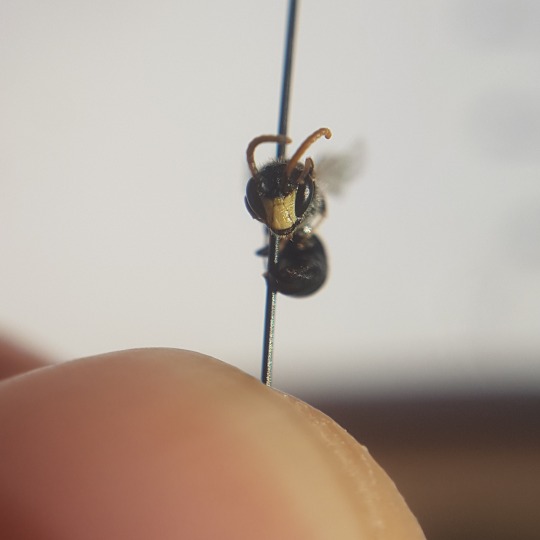
The next is a Leafcutter. Fascinating little bees who make their nests in holes packed with... you guessed it leaves! They cut out little circles of leaves and fly off with them which is fun to watch. Even if you dont see the bees themselves youll see the impact on the leaves. Another interesting thing about Leafcutters is that the females have a pollen brush on the underside of the abdomen rather than on the legs! Thats what that vibrant orange fuzz is underneath.
A. fulva also known as the Tawny mining bee is a very common bee and is really easy to identify. The males however are slightly more complicated the males of many Andrena species of hard to tell apart and often require a hand lense to seperate. This particular bee is seperated by looking at the length of a section of antennae so good luck with that.
Theres much more to look at so stick around.
19/04/20
#vulture culture uk#vulture culture#taxidermy#bones#skull#skull collecting#animal skull#pinned insects#curiosities#oddities
17 notes
·
View notes
Photo

Hawaiian Yellow Faced Bee
Hylaeus longiceps
Source: Here
222 notes
·
View notes
Photo

this is the yellow-faced bee (scientific name: hylaeus)! commonly mistaken for a wasp because of its distinct coloration and virtual lack of hair, the yellow-faced bee is particularly slender, which helps it squeeze into flowers to collect nectar and pollen!
3 notes
·
View notes
Text
Chat With a Scientist: Hawaiian Pollinator Edition

Dr. Plentovich examines a species of yellow faced bee that has only been observed on O’ahu a couple of times in the last decade. Photo by Cynthia King
In the early 1900′s the yellow-faced bees were some of the most commonly found insects in Hawai’i. By the early 2000’s they were in sharp decline, and in 2015 seven species of Hawaiian yellow-faced bee were added to the federal Endangered Species List.

Hawaiian Yellow faced bees can only bee found in the Hawaiian islands. Photo by S. Plentovich.
We spoke with U.S. Fish and Wildlife Service biologist Dr. Sheldon Plentovich about what makes the Hawaiian yellow-faced bees so special, why they are in trouble, and what you can do to help.
Oʻahuʻs north shore may be most famous for its world class surf breaks, but it is also home to some of the best wildlife viewing opportunities in Hawaii.
Spend a day exploring O’ahu’s north shore and you could find yourself face to face with an endangered Hawaiian monk seal or Hawaiian green sea turtle basking on the beaches (be sure to be a respectful wildlife watcher).
You could visit the albatross colony at Ka’ena Point during fledging season and watch as some of the most magnificent flyers on the planet learn how to use their wings, or you could dip below the surface in one of the north shore’s amazing snorkeling spots and swim with all the fishes.
But hidden away on the eastern corner of the shore is one of the lesser known wildlife communities in Hawaiʻi. There along the quiet coastal strand of James Campbell National Wildlife Refuge is one the last remaining habitats for the endangered Hawaiian Yellow-faced bee, and itʻs where Dr Sheldon Plentovich and scientists from the Hawai’i Department of Land and Natural Resources and the University of Hawaii are working to keep the bees from going extinct.
What is so special about Hawaiian yellow-faced bees?
SP: Hawaiian yellow-faced bees are special because they are Hawaii's only native bees and all of the species are endemic - meaning that Hawaii is the only place on the planet where they can be found. There are about 60 species of these bees that all descended from a single species ancestor who arrived on the islands approximately one million years ago.
Hawaiian yellow-faced bees can be found in a variety of habitats from coastal to montane environments. They nest in hollow tubes sometimes in soil or rocks on the ground and sometimes in the hollow stems of plants.
The bees depend on healthy intact native plant communities and have struggled to cope with habitat loss and the threats of invasive species.
Non-native plants have pushed out the native plants the bees use for food and habitat, while invasive ants attack the bees nests and exclude the bees from their food source, flowers.

There are 7 species of Hawaiian yellow faced bee that are endangered, including H. anthracinus, pictured here. Photo by J. Graham.
What are the threats to Hawaii's endangered bees?
SP: Arguably the biggest threat to Hylaeus are invasive ants (and all ants in Hawaii are introduced). Invasive ants have likely shaped the distribution of Hylaeus today. For example, H. anthracinus probably nested on the ground a lot more often in the past. But when the invasive Big-headed ant was introduced to Hawaii, it likely excluded H. anthracinus from places where it had been living.
Now at James Campbell National Wildlife Refuge, H. anthracinus does not nest on the ground because of high densities of Big-headed ants and other species. Other threats include habitat loss and competition with introduced bees and wasps
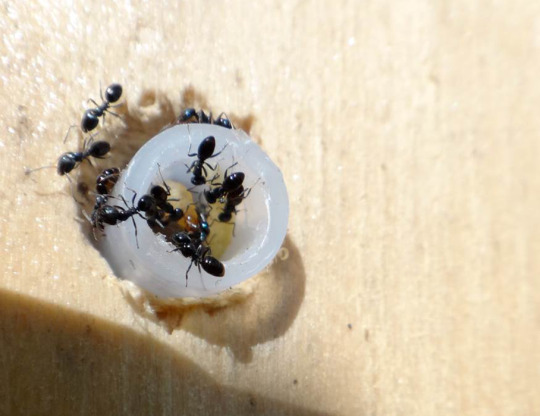
Invasive ants are a major threat to Hawaiian yellow faced bees. The ants attack the bees’ nest sites and eat the larvae. Photo by S. Plentovich
What can people do to help Hawaii’s endangered bees?
SP: One of the biggest things we can do is protect coastal habitat and be aware of where these bees live. H. anthracinus, for example nests in hollow twigs in coastal vegetation, so protecting coastal vegetation in large intact patches is very important. A number of volunteer groups in Hawaii work to protect coastal habitat, so volunteering is another way folks can help get involved.
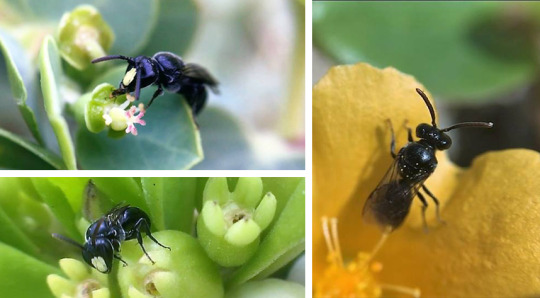
Hawaiian yellow faced bees rely on native plants like the coastal Naupaka, Akoko, Ilima and for their survival. Photo by Jason Graham.
What is the U. S. Fish and Wildlife studying at James Campbell right now?
SP: We are working on a study to help understand the effects of invasive ants on nesting Hylaeus, and we are testing artificial nest blocks that are designed to prevent the invasive ants from getting in and eating the bee larvae and pupae. We are hoping we can expand the Hylaeus population at James Campbell by improving habitat and providing more nesting opportunities.
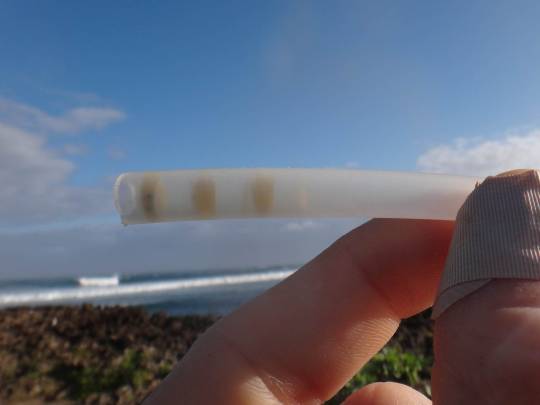
An experimental nest tube. Scientists are working to see if they can help the bees by creating safe places for them to nest.
How will this research help the bees in the future?
SP: This research could help us understand what kinds of concrete actions we can take to protect Hawaii’s endangered bees. Right now we don’t have a lot of tools to help protect Hyleaus because we know so little about the things that limit their population.
What are some of the more exciting recent discoveries about Hawaiian yellow-faced bees?
SP: There is still a lot to learn about these bees. Earlier this year we found one of the endangered bee species, H. longiceps, at James Campbell National Wildlife Refuge. That particular species had not been on that part of the island in many years so seeing one there was really exciting. These bees have such small and restricted ranges that each patch of habitat is incredibly important.

The shoreline of James Campbell National Wildlife Refuge.
Just a few weeks later, we discovered a large population of that same species at the Mo`omomi Preserve on Molokai. While we knew that the bees were there, that was the first time we were able to find and see where they nest.

Researcher examines Hawaiian yellow faced bee burrows on Molokai.
The U. S. Fish and Wildlife Service Coastal Program is working closely with universities and community groups to help understand and protect Hawaiian yellow faced bees and their habitat around the state of Hawaii.
youtube
Dr. Sheldon Plentovich is the Pacific Islands Coastal Program Coordinator for the U.S. Fish and Wildlife Service.
9 notes
·
View notes
Text
Bees May Mass Produce An All New Type Of Waterproof Material
Bees May Mass Produce An All New Type Of Waterproof Material
Bees are amazing insects. Not only do they provide the world with the sweet-tasting honey, but they also provide nearly all of the agricultural food products that we take for granted. In addition to providing humanity and many other animals with an invaluable service, researchers have recently found good evidence to suggest that bees are easily the smartest insects in existence. Unlike most insects, bees are not your typical creepy-crawlies that are deserving of disdain; instead, bees enable humans to survive on this planet. Of course, the pollination of the world’s agricultural crops is an essential service that bees perform, but soon they may also keep people from succumbing to harsh outdoor conditions. A startup company based in New Zealand is attempting to synthesize a material that mimics the sturdy nests that bees create. Manufacturing this material will not add pollutants to the environment, unlike other textile manufacturers. The material may also prove to be the most effective form of protection against the damaging effects of water and cold temperatures.
A New Zealand native, Veronica Harwood-Stevenson, has created Humble Bee, which is a startup company that is aiming to produce outdoor waterproof products such as coats, pants and tents with a more durable material. Humble Bee is unique for being one of the few companies to explore the benefits of biomimicry. Harwood-Stevenson is hoping to mass-produce a cellophane-like material that is made from the same materials that bees create in order to build their nests.
In order to create this revolutionary material, Harwood-Stevenson is focusing on the yellow-faced Hylaeus bee. Like most bees, the Hylaeus bee pollinates flowers, but they do not build independent hives; instead, these bees build protective cell linings where they store their food. These cells are built into natural crevices that are found in nature, such as on trees. This cell is made from a super sturdy and waterproof lining that could keep humans well-insulated. Harwood-Stevenson is funding her research into this bioplastic material with prize money that she won from the Wellington Regional Economic Development Agency’s Bright Ideas Challenge.
Do you think that biomimicry involving insects will one day become the standard for producing durable materials that are meant to keep humans safe?
from Tips About Pest Control https://certifiedtpc.com/2018/06/21/bees-may-mass-produce-an-all-new-type-of-waterproof-material/
0 notes
Video
Yellow-face Bee by Oliver Andrews
Via Flickr:
A very small bee, one of the hylaeus, or yellow-face, species (probably hylaeus hyalinatus) sitting on a buddleja flower bud.
#30dayswild#bee#bees#canon#canonuk#garden#hairy yellow-face#hylaeus hyalinatus#insect#insects#invertebrate#invertebrates#minibeast#minibeasts#nature#outdoors#springwatch#wildlife#flickr
3 notes
·
View notes
Text
@headspace-hotel
kicking off niche nature thing that I’m interested in and I wish more people knew about: Hylaeus bees!
this genus has over 500 species on every continent except Antarctica. they’re also known as masked or yellow-faced bees, and my fave fact is that some are associated with strong smells - a european species reportedly smells like lemons!
a lot of them are on the steady decline, but there’s not a lot of well put together information about them there either! a lot of species don’t even have a wiki page.
#inspired by your post hope this is okay!#you just got me thinking about some of my fave lads again#katie rambles
5 notes
·
View notes
Photo

A Hylaeus (Masked Bee) of some kind of the female gender from somewhere in Kenya from Laurence Packer's extensive bee collection up in York, Ontario. I spent about 10 days once upon a time up in Laurence's lab just taking cool bee pictures. Those pictures became a small Laurence and Sam book (now out of print) which can be summarized as cool bees with cool stories from a couple of Bee Hunters. This is a left over picture that did not make book grade, my notes are who knows where and I only have the notion that it is some sort of masked bee. A relatively successful genus with 761 names recorded on the Discoverlife Bee Species Finder Page (https://www.discoverlife.org/mp/20q?guide=Apoidea_species&flags=HAS: ) definitely worth spending some downtime looking at all the fascinating combinations of country and bee genera totals (and loads more taxonomic fun).
55 notes
·
View notes
Text
Types of bees
Native bees
At least three native bee species have a basic social structure, a bit like the introduced honeybee and bumblebee. The rest are solitary, although they may make nests close together.
Native bees pollinate many native plants. They are also widespread in kiwifruit and apple orchards and some vegetable crops, and may be important pollinators in horticulture.
Leioproctus bees
The most commonly seen native bees are 18 species of Leioproctus. These bees are robust and hairy, looking similar to honeybees but smaller (5–12 millimetres long). All are black except for the South Island speciesLeioproctus fulvescens, which is covered with dense orange–yellow hair. They are often seen in summer carrying pollen on their back legs, like honeybees and bumblebees.
They dig nest holes in the ground, and sometimes a nesting area riddled with bee holes gives the impression of a colony. A small pile of soil is the usual sign of individual nest tunnels. Each species prefers a specific type of soil. For example, Leioproctus fulvescens needs fine-grained soil, while Leioproctus metallicus nests in coastal sand.
Hylaeus bees
The seven Hylaeus species are 7–9 millimetres long, and slender. Almost hairless, they are black with small yellow markings on the face and thorax. They make nests in blind tunnels in twigs and branches, or in old beetle holes in logs. They have no special pollen-carrying structure on the back legs, so carry pollen in the stomach.
Lasioglossum bees
The smallest (4–8 millimetres long) and most easily overlooked native bees are four species of Lasioglossum. They are black or greenish, only moderately hairy, and nest in the soil. At least one species, Lasioglossum sordidum, has adapted well to modified habitats. Its nests are often found along fencelines, on horticultural land sprayed bare with herbicides, and on stopbanks and ditch sides above water level.
we will probably only be concretrating on one or two types of bees to make it less confusing for the little ones, but also making sure that they know the lifecycle of them and the pollination process.
0 notes
Photo

The U.S. Fish and Wildlife Service announced Tuesday on its website that the rusty patched bumblebee (Bombus affinis), once a common sight, is “now balancing precariously on the brink of extinction.” Over the past two decades, the bumblebee’s population has declined 87 percent, according to the announcement. The news comes just a few months after the first ever bees were declared endangered in the U.S. In September, seven species of Hawaiian bees, including the yellow-faced bee (Hylaeus anthracinus), received protection under the Endangered Species Act. (Read “For the First Time, Bees Declared Endangered in the U.S.”)#bees#racingextinction#nationalgeographic#unitedstates#first time
0 notes
